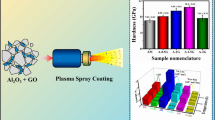Abstract
The effect of firing conditions on the adherence of a glass-bonded Pt-Au printed thick film conductor to a 96 wt % Al2O3 substrate was determined by a fracture mechanics measurement of the critical fracture energy for catastrophic thick film-substrate separation. The technique also demonstrated that separation by slow crack growth (delayed failure) occurred in this system. Analysis of the thick film microstructure and fracture surfaces showed that optimum adherence was primarily a result of a mechanically interlocked interface formed between the conductor metal and the glass bonding layer which, in turn, was strongly bonded to the alumina substrate. The two step decrease observed inγ IC (from 3.7 to 0.2 J m−2) with firing temperatures over 860° C resulted from the removal of this interlocking metal-glass interface brought on by metal sintering and glass migration to the substrate. Thus, at 860° C firing temperatures, adherence is controlled by cohesive fracture in the glass bonding phase while above 1000° C it is controlled by adhesive failure of the weak chemical-physical bond at the metal-glass interface.
Similar content being viewed by others
References
M. E. Twentyman,J.Mater. Sci. 10 (1975) 765.
G. Elssner, S. Riedel andR. Pabst,Pract. Metall. 12 (1975) 235.
G. Elssner andR. Pabst,Proc. Brit. Ceram. Soc. 25 (1975) 179.
T. T. Hitch, inProceedings of the International Microelectronics Symposium, International Society for Hybrid Microelectronics, Montgomery, Alabama (1971) pp. 7-7.1–4.
B. N. Chapman,J. Vac. Sci. Tech. 11 (1974) 106.
P. F. Becher, W. D. Bascom, J. L. Bitner, andJ. S. Murday, in Proceedings of International Microelectronic Symposium, International Society for Hybrid Microelectronics, Montgomery, Alabama (1975) pp. 079–86.
S. J. Bennett, K. L. Devries, andM. L. Williams,Int. J. Fracture 10 (1974) 33.
E. J. Ripling, S. Mostovoy, andH. T. Corten,J. Adhesion 3 (1971) 107.
E. J. Ripling, S. Mostovoy, andC. Bersch,ibid 3 (1971) 145.
W. D. Bascom, C. O. Timmons, andR. L. Jones,J. Mater. Sci. 10 (1975) 1037.
S. W. Freiman, D. R. Mulville, andP. W. Mast,ibid 8 (1973) 1527.
K. R. Bube andT. T. Hitch, Quarterly Technical Report No. 1, Contract Number N00019-75-C- 0145 (NAVAIR), RCA Laboratories, Princeton, New Jersey, April 1975.
G. J. Copley andA. D. Rivers,J. Mater. Sci. 10 (1975) 1291.
G. J. Copley, A. D. Rivers andR. Smith,ibid 10 (1975) 1285.
S. M. Wiederhorn,J. Amer. Ceram. Soc. 52 (1969) 99.
J. J. Mecholsky, R. W. Rice andS. W. Freiman,ibid 57 (1974) 440.
D. R. Biswas andR. M. Fulrath,ibid 58 (1975) 526.
S. M. Wiederhorn,ibid 58 (1967) 407.
Author information
Authors and Affiliations
Rights and permissions
About this article
Cite this article
Becher, P.F., Newell, W.L. Adherence-fracture energy of a glass-bonded thick-film conductor: effect of firing conditions. J Mater Sci 12, 90–96 (1977). https://doi.org/10.1007/BF00738474
Received:
Accepted:
Issue Date:
DOI: https://doi.org/10.1007/BF00738474




